Spring is here in New England! Lilacs are in bloom, the days are getting longer, the Red Sox are in first place, and the striped bass are arriving in good numbers. Truly a great time to be alive. I caught my first striper on May 7 and have had increasing success each day since, with more fish arriving or becoming active as the weather and water warm. As I write this, I've just returned from a few hours fishing in the Inner Harbor area. The fishing was excellent with two fish over 26 inches and numerous smaller fish. Lots of action and for the first time some of it on top with Gurglers. Yesterday yielded a 37 incher—my best fish this season and a superb fish at any time of the year.
The striped bass season in Boston lasts six months, spanning spring, summer, and fall. Here are strategies and tips to help you make the most of the first third of the season.
While there are always some holdover striped bass in the Boston Harbor area, most of the fish we find during striper season are migratory. These migrators leave their southerly spawning and winter-over waters sometime in April (the precise date dependent on the weather and water temperature). They reach the Boston area around the first week in May. By the third week in May stripers can be found in good numbers in many Boston area locales accessible to the wading fisherman. But they're not everywhere: You have to look for them—or rather, know where to look for them. And, having found them, you have to know how to fish for them.
Expect the Unexpected
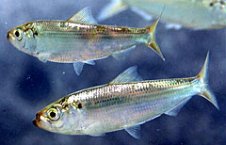
Alewife
If there's one word that describes early season striper fishing it's "unpredictable." The weather is one day cold, the next warm. The water temperature fluctuates sharply. Newly arrived striped bass move frequently as they get get acquainted with their new surroundings, checking out each place for food and comfort. Many follow schools of bait fish (herring, alewives and silversides) that move into rivers, estuaries or inter tidal zones for their annual spawn. Some days you'll catch bass in large numbers; other days, they are few and far between. The size of the bass you're likely to catch is also unpredictable, with smaller ones abundant and only the occasional large fish among them (although that said, I usually catch most of my 36 inch-plus fish in the early spring and summer).
So you must be patient. Since water conditions and numbers of fish are often inconsistent, be prepared to spend time on and in the water if you hope to be successful.
It's important to remember also that even the water you've been fishing for years—the underlying structure—will be unpredictable. Winter storms move rocks, shift sand and gravel bars, fill in old holes, scoop out new ones, shallow out some channels and deepen others. When approaching old and once-familiar spots be prepared to notice the changes and to relearn the best ways and times to fish them. A good general rule, for safety's sake if not for the sake of good fishing, is to time your first visit so that you're there about two hours before low tide, preferably a "minus" low, so that you can fully and safely observe the changes that have taken place over the winter. Never approach an unfamiliar piece of water on the incoming tide. You'll not only not learn much about the place but you may be putting yourself in danger. In many places the most productive times for fishing for the wading shore fisherman are in any case generally two-three hours before low to two-three hours into the rising tide.
Where and When to Fish
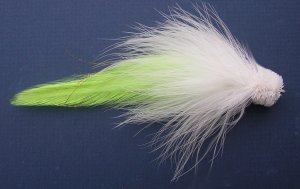
Beastmaster General
Striped bass are most active in water 52 degrees Fahrenheit and above. In water colder than that they tend to hold deep or keep moving until they find warmer water. Estuaries, rivers, shallow bays, and areas artificially warmed by, say, power plants, are places where you can expect to find a fair number of early season arrivals. Conversely, due to it colder water, oceanside, deep water fishing is generally far less rewarding in the early part of the season. Fishing in the afternoon, when the water has had a chance to warm up, is generally more productive than in the morning when the water has cooled off overnight. When fishing an estuary or river you should expect better fishing on an outgoing tide (with the warmer water) than on an incoming tide bringing with it cold water. I prefer the last two or three hours of the falling tide, especially when low tide occurs sometime between 5 pm and 9 pm. Larger tides are generally more productive than smaller ones (which high low tides and low high tides). So if your fishing time is limited you'll do well to check out a tide chart and make your plans accordingly.
If fish are actively feeding on top, then obviously it's wise to keep your fly there. But often there's no visible clue as to where the fish are holding. If the water is cold on the surface they most likely are holding deep and that is where you should fish your fly. When I approach a new spot I like to start out by fishing my fly close to the surface. This I'll do for a few casts. On the next few casts, I'll let it sink a couple of feet. And then a few casts later, deeper still until I locate a fish or two. Then, when I've discovered a pattern, I'll fish the fly consistently at the level at which the fish seem to be holding (or at least willing to take a fly). When blind-casting I generally try to cover as much water as I can, moving from likely place to another until I start picking up fish on a regular basis. I don't recommend standing in one spot like a statue and just hoping the fish will come by. At times this may be productive—if you're fishing a rip, for instance, or a jetty or off some rocks, where fish are known to put in a regular appearance. But it's more fun and you'll learn more about the bottom structure and the movements of fish if you move around. Explore with your feet and with your rod all the likely-looking places you can within the time you have on the water.
Tackle for Early Season
If fishing an area noted for small fish, a 6 weight rod and matching line will do nicely. For heavier fish, an 8 weight will handle just about anything you're likely to catch. For lines I recommend a clear intermediate fly line (I like Airflo and Rio). Leaders should be about 7 feet long, tapering to a 15-pound test tippet (or as light as 10-pound if you are fishing for smaller fish).
Flies for Early Season
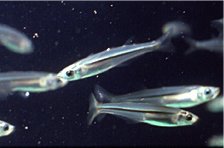
Silversides
Early in the year, many waters hold spawning herring and stripers slurping them up. In these areas (for example, the locks at the Charles River or the Amelia Earhart Dam) I like to fish a large herring imitation, skipping and dipping a Herring Gurgler or Slider over the surface if the stripers are taking them on top or fishing the Herring FishHead or Herring Master very slowly and deep if the fish are holding deep. If silversides are present, especially in an estuary, I like to dead-drift and/or swing a small white Soft Hackle Streamer or Soft Hackle Deceiver into the paths of feeding fish, not moving the fly much but just twitching it occasionally to make it look alive.
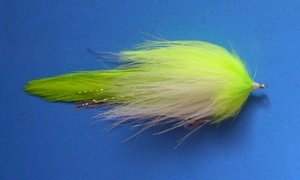
Beastmaster
When no fish are obviously feeding and I'm forced to blind-cast (which is often the situation in spring), I prefer to fish a large (5-6 inches long) streamer with a lot of built-in action like a 1/0 BeastMaster, usually chartreuse/white since spring water is often discolored and the bright fly stands out in the dingy water. If there's an abundance of smaller stripers and I'm getting a lot of short strikes on the larger fly I'll often switch to a smaller fly, say a 3-4 inches long 1/0 chartreuse/white Soft Hackle Deceiver. If I have to fish deep, I may switch to a Depth-Charger Soft Hackle Deceiver but being lazy I usually just add a split shot or two to my leader.
As the water warms and stripers begin showing an interest in surface flies, I recommend Gurglers when the surface is relatively calm and Sliders when it isn't. At this time of year, these flies are best fished rather slowly. In fact, using slow retrieves rather than fast ones is a good general rule for all spring fishing. The fish at this time of year don't seem to be as willing to chase a fly as they will be later in the season.
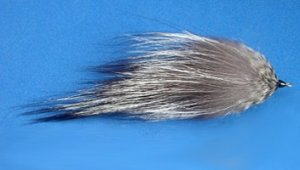
Silver Fox Streamer
If I'm fishing near sundown and have had my fill of smaller fish I may switch to a fairly large fly such as a 1/0 BeastMaster General about 6 inches long. This fly has a deer hair head and a very full profile, one that seems more tempting to larger fish than to smaller ones. Fishing this fly slowly just under the surface seems to produce the best results. Recently I've also having success with a fly I call a Silver Fox Streamer, (since this is the material that it's tied with). It's 6-7 inches long, very full-bodied, and in the water has a swimming action that has to be seen to be believed. Since it's a rather dark fly, I've fished it only late in the afternoon towards dark; during the day I prefer a lighter fly that's more visible—to me if not to the fish.
Pay Attention to Your Retrieve
No matter which fly you choose it won't matter if you don't fish the fly well. Practice various retrieves—from fast to slow to in-between. Or simply dead-drift it in a moving current. Play around with the fly. See what it does in the water, how it moves, how it responds to the actions you give it with both your hand and your rod tip. And, most important, see how the fish respond to each type of retrieve. If you find that one retrieve works better than another, then that's the retrieve you want to concentrate on—at least until it stops working. Currents are always changing speed, water conditions and striper moods will often dictate the speed and rhythm of your retrieves so you must always be willing to experiment. Don't just chuck the fly out there and bring it back to you willy-nilly; give thought to the action you want to give the fly. You'll be much more amply rewarded than the zoned-out angler who puts his brain in neutral, goes through the motions, and hopes for the best.
Boston Area Spots for Early Season
South Shore:
Fore River, Weymouth
Weir River, Weymouth
Neponset River, Quincy
Quincy Bay, Quincy
Boston Proper:
Charles River, Boston (all the way up to Watertown)
Mystic River from Amelia Earhart Dam all the way up to the dam at Upper Mystic Lakes (lots of herring here in season)
Dorchester Bay, Boston
Chelsea Creek, Chelsea
North Shore:
Belle Isle Creek, Winthrop/Revere
Pines River, Revere/Lynn
Danvers, Jones, Essex and Merrimack Rivers
Lynn Harbor, Lynn
Joppa Flats, Newburyport






